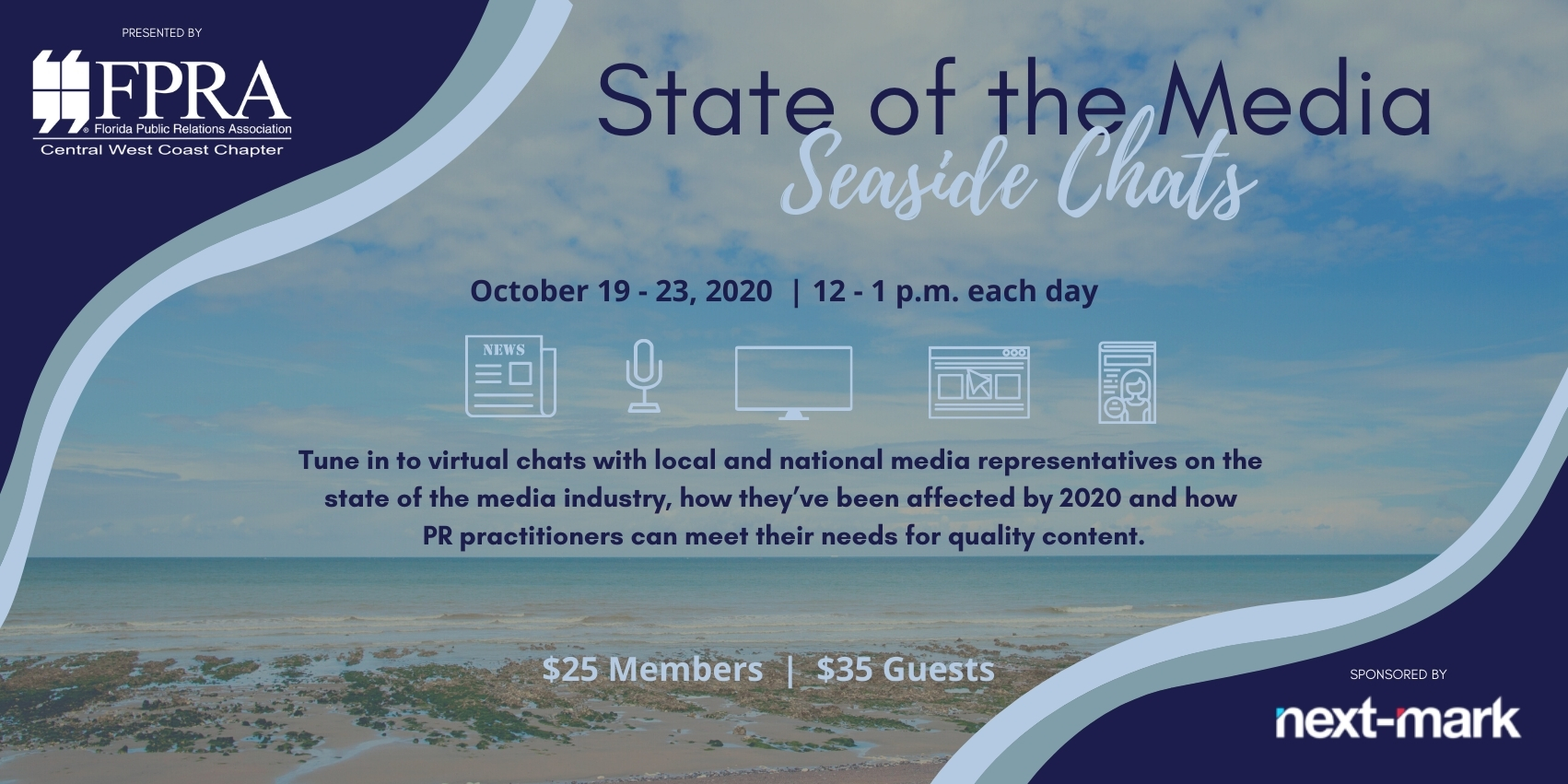
The event provided attendees with insight into the challenges facing journalism today
Recently, our chapter hosted “State of the Media: Seaside Chats,” a five-part virtual series highlighting the challenges facing journalism today, including the effects of a global pandemic, a suffering economy and an incredibly divisive political environment.
Each hour-long session featured a different media representative from a broadcast, newspaper or magazine outlet, sharing valuable insights and expert advice on how to maintain mutually beneficial relationships with the media in today’s ever-changing landscape.
In case you missed one of these sessions, here are some of the highlights and key takeaways:
RADIO: Nikki Clark, iHeartMedia
- iHeart Media is the largest media company in the U.S., with stations locally in the Sarasota market.
- Remember: Radio is flexible and more conversational than other forms of media, allowing for in-depth coverage, and access to on-air talent for endorsements.
- The pandemic has transformed radio. Many systems are now automated and all talent is working from home in their own studios. The ability to work from home will probably stay even after the pandemic is over.
- Audio and video assets are welcome, in addition to written press releases or announcements.
NEWSPAPER: Matt Sauer, Sarasota Herald-Tribune
- Newspapers need help from PR professionals more than ever because reporters are not on the street as much now – they’re working remote too!
- The Herald-Tribune is now owned by Gannett, making it part of a larger national network of 260 daily newspapers, including USA Today. These papers are all hungry for stories, so national attention is possible for local stories.
- Herald-Tribune reporters are looking for positive news stories as a way to provide some relief from all of the negative news we see today.
- Stories covering retail, healthcare and politics are popular with readers, and lists are still popular too.
- When pitching the Herald-Tribune, keep these key contacts in mind: the main assignment editors are: Victor Hull and Lee Williams; Arts: Jay Handelman; Entertainment: Wade Tatangelo; Sports: Scott Peterson; and Business: Victor Hull.
- Press releases can also be submitted through Heraldtribune.com/submit. This method is best for general announcements.
NATIONAL MEDIA: Becky Ferreira, freelance science reporter, VICE regular contributor
- As a freelancer, she gets tips directly from PR people and she’s eager for relevant pitches.
- For a story to go viral, it must be visual and have a compelling headline. A mystery and/or an expedition into something new is also enticing, especially in science reporting.
- If a reporter/writer makes a mistake in your article, alert him or her politely.
- Find poetic treatment for more esoteric or mundane stories, in particular ones without great images. She gave an example of a black hole that the PR person described as “glittering.”
- It’s ok to follow up after a pitch – once or twice at most.
MAGAZINES: Susan Burns, Sarasota Magazine
- Sarasota Magazine has switched its focus to digital and publishes a print magazine only six times a year. Its subscribers are in every state and several countries.
- The magazine produces themed newsletters and creates curated slideshows, as well as webinars and sponsored content.
- To move up the list for editorial coverage, provide high-quality images with your press release.
- Send submissions three months in advance to be considered for inclusion in the printed magazine.
TELEVISION: Jack Conely & Michael Miner, WEDU PBS
- WEDU has six channels of programming and a wide reach — from Crystal River south to Nokomis and west of Orlando to the Tampa Bay area.
- Viewership has increased since the pandemic because more people are at home. One new way they are interacting with viewers is through YouTube live streams.
- The station produces 100 hours of original programming a year and they’re working to increase that number. Their productions include town hall meetings, Florida Political Roundtable and a weekly arts magazine (non-profits have been providing their own content).
- Before pitching, look at the website to see what WEDU is already doing and how your organization or client can fit in.
- A new Greater Sarasota program was made possible by sponsorship from the Community Foundation of Sarasota County. It’s a digital-first program and runs 7-8 minutes long. The segments will eventually be stitched together into a longer program. They see this as a pilot program that can be replicated in other PBS markets, as long as there is a sponsor.
- There are sponsorship opportunities in print, on TV and digital platforms. For more information, contact Michael Miner (mminer@wedu.org).
If you were an event attendee, recordings of each session have been made available. Please contact info@cwcfpra.com for more information.
